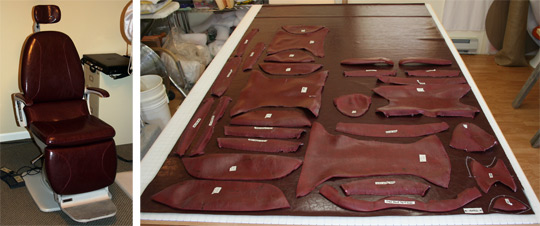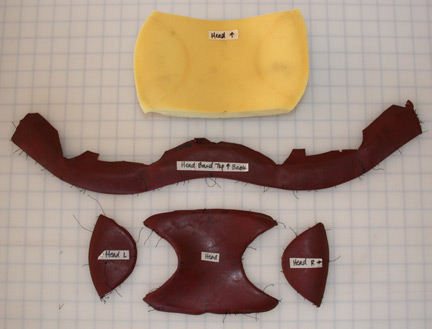Now your project is clean, newly padded, and ready for the final fabric layer – the dressing, the final transformation, the ‘piece de resistance’!
In this step you will use your labelled pattern pieces from the original fabric removed in Step 4 – Deconstruction. Steaming helps to flatten the worn & creased pieces if you need them for direct patterning – it is a good idea to keep one side of paired pieces intact (for example, you may steam-flatten the left inside arm and leave the right inside arm intact) as it may provide a helpful reference when fitting the new pieces to the chair.

The original pieces were used for patterning on this multi-section exam chair

The headrest section of the exam chair deconstructed and ready for patterning

Tracing around the original pieces with chalk & the finished headrest section
Cutting the new fabric is often the scariest step for upholstery students, the following guidelines will help to ensure your success:
- Before making the first cut, be sure your layout includes all the pieces you need – if necessary refer to your layout chart from Step 2 – Measuring
- Label each piece with sticky notes or masking tape (always test before applying any kind of tape to your fabric)
- Depending on the complexity of your project, you may want to use the original fabric pieces for patterning – tracing around them onto the new fabric with chalk
- In general, your new pieces will be 4-6 inches larger than the dimensions of the original pieces in each direction to allow ‘tugging room’ for stapling (stitched pieces will require less than this for seam allowances)
- If you have chosen a repeating pattern for your fabric, you will need to match the pattern from one section of your chair to the next, so layout placement is important in order to line up the pattern
- Fabrics without a ‘nap’ or directional texture are the easiest for a first project (for example velvet can be challenging to work with)

This chair’s front band was patterned from the original piece to wrap cleanly at the corners
Remember to ‘measure twice and cut once’. When in doubt about the fit of a difficult section, make a pattern out of a piece of muslin or similar inexpensive fabric before cutting into your final upholstery fabric.
Previous: Step 6 – Reconstruction: Padding
Next: Step 8 – Reconstruction: Applying Fabric to the Inside Surfaces of your Chair
Join NaturalUpholstery.com’s mailing list to receive our monthly newsletter with reupholstery tips, creative inspiration, and resources for using natural, non-toxic materials for upholstery.